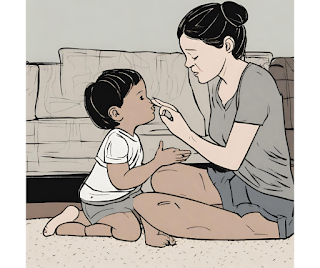By: Dr. Gabriel Rodriguez
Introduction
However, teaching mindfulness to busy, energetic toddlers can seem daunting. Toddlers live very much in the moment, so asking them to sit still and focus on their breathing may be asking a lot! The key is to start small, keep it simple and interactive, and weave mindful breathing into their daily routines.
In this post, we’ll share tips on how to introduce mindful breathing to your toddler in an engaging, age-appropriate way. Teaching this important lifelong skill early can help set them up for better self-regulation, concentration, and handling of big emotions. With patience and making it fun, you’ll be surprised how quickly toddlers can learn to re-center with some deep belly breaths!
Getting Started with Mindful Breathing
When beginning a mindful breathing practice with your toddler, set yourselves up for success by keeping the following tips in mind:
Creating the Right Environment
- Find a quiet, low-distraction space. Have them sit comfortably with legs crossed or in front of them. Make sure they aren’t hungry or needing a diaper change first.
- Use a calm, soft tone of voice with relaxed body language. This helps signal it’s time to settle. Take some deep breaths yourself to model it.
Timing and Duration
- Start with brief 1-2 minute sessions. Toddlers have short attention spans, so don’t drag it out too long.
Making It Interactive
- Make it interactive and fun by using bubbles, pinwheels, or stuffed animal bellies that rise and fall with breath.
- Give positive reinforcement like high fives when they try breathing with you. But don’t scold or force it if they get antsy.
Consistency and Patience
The key is keeping it short, fun, and pressure-free. If they resist or get silly, don’t worry - just try again later. With regular practice, they will start to get the hang of deep belly breathing.
Everyday Mindful Moments
Once your toddler gets the basic idea, look for opportunities to have “mindful moments” organically woven into your daily routine:
- Practice mindful breathing together while waiting in line at the store or for food at a restaurant.
- Use a singing bowl or gentle chime sound to refocus their attention on breathing before meals.
- Have them take deep breaths to blow out birthday candles or dandelions. Make a wish together.
- When they get upset, guide them through some belly breaths to find calm. “Let’s stop and take 3 deep breaths.”
Making Mindful Breathing a Habit
To help mindful breathing stick:
Scheduling and Routine
- Try to set a regular schedule, such as doing a few minutes at wake-up time and before bed. Consistency helps cement habits.
Model Behavior
- Model it yourself - when you notice yourself stressed, take some deep breaths. Narrate this for your toddler.
Positive Reinforcement
- Offer plenty of praise and encouragement when they participate or remember to breathe. Stickers are great positive reinforcement!
Persistence and Patience
- Be very patient. It takes time and consistency for new skills to become ingrained habits. Don’t give up!
Conclusion
Teaching mindfulness and mindful breathing to your toddler comes with many rewards, including reduced stress, better sleep, improved concentration and self-regulation. But it does require commitment and patience - after all, we're trying to get wiggly toddlers to sit still and focus!
By starting very short, keeping it simple and fun, and integrating mindful breathing into your regular routines, you'll start to see your kiddo re-center themselves with some belly breaths. Over time, this invaluable lifelong skill will become second nature to them.
What tips have worked for teaching your toddler mindful breathing? Share in the comments below! And remember to breathe deep yourself - parenting young ones is stressful, but a few mindful moments a day can make a big difference.







0 comments:
Post a Comment